Philodendron panduriforme is a rare climbing houseplant with adorable three-lobed, fiddle-shaped dark green leaves. This low-maintenance plant will add a sensational tropical appeal and purifies the air.
Discover more about what it looks like (appearance) and care or growing needs like light, soil mix, temperature, humidity, feeding, etc.
That is not all. We will also tell you where to buy it, Etsy.com being the best place and prices. And since many people mislabel it, there is a Philodendron panduriforme vs. bipennifolium that will guide you on how to tell these two plants apart.
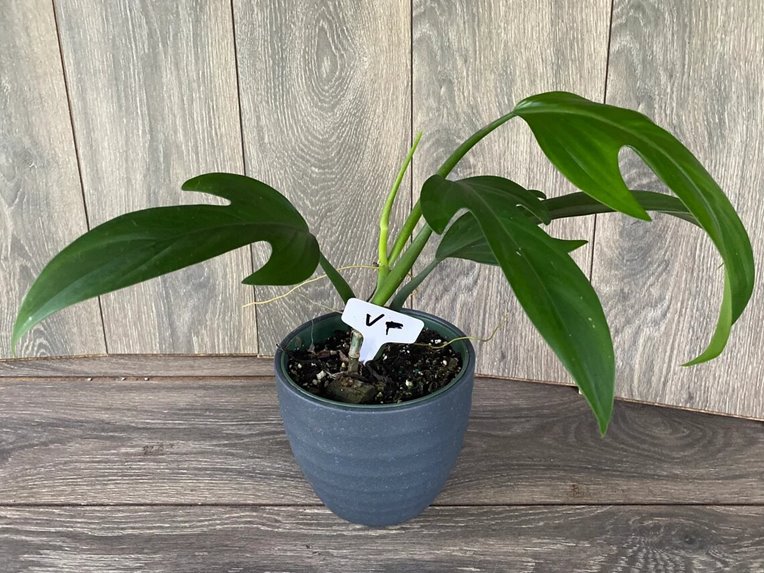
Contents
- Quick overview
- Description and identification
- 1. Growing habits
- 2. Growth rate and size
- 3. Leaves
- 4. Stems
- 5. Flowers
- Varieties
- Philodendron panduriforme vs. bipennifolium
- Philodendron panduriforme care
- 1. USDA hardiness zone
- 2. Temperature
- 3. Humidity
- 4. Light needs
- 5. Soil mix
- 6. Watering
- 7. Fertilizer
- 8. Pruning and grooming
- 9. Repotting
- 10. Support
- Philodendron panduriforme propagation
- Issues or problems
- 1. Pests and diseases
- 2. Root rot
- 3. Leaf discoloration – yellowing or browning
- 4. Leaves curling and your plant drooping
- Where to buy Philodendron panduriforme
- Frequently asked questions (FAQs)
Quick overview
- Scientific name: Philodendron panduriforme
- Common names: Wolf’s Head Philodendron, Philodendron Panda, or Panda Plant
- Family: Araceae
- Native habitat: Guyana, Venezuela, Ecuador, Brazil, and Colombia
- Toxicity: Toxic to cats, dogs, and humans
- Care level: Low maintenance or easy
Description and identification
1. Growing habits
Philodendron panduriforme is low, loosely climbing hemiepiphyte native to the Amazon basin. It occurs from Southern Guyana and Venezuela (Amazonas) to Ecuador, Colombia, and western parts of Brazil and occurs between 328-2296 feet (100-700 meters) above sea level.
Like most other Philodendron species, it undergoes morphogenesis. Therefore, baby and juvenile plants will look distinctive from mature or adult plants.
2. Growth rate and size
It has a moderate to fast growth rate and can grow up to 10 feet (3 meters) or more while in the natural habitat. However, at home, expect it to be about 6 to 8 feet, and to be this tall, you must give it a place to climb.
3. Leaves
What you see in the houseplant trade is juvenile and subadult plants as mature leaves are tri-lobed.
Juvenile plants have oblong to oblanceolate (inverted lance-shaped), 10.8 inches long, dark green leaves. Their widest part is beyond the middle section of the leaf, while they are narrowest at the base, just above the slightly flaring lateral lobes.
On the other hand, mature Philodendron panduriforme plants will have larger (up to 16.9 inches long by 13.4 inches wide) fiddle-shaped, three-lobed (nearly equal in size), leathery to moderately leathery, semi-glossy to matte, dark green leaves with a hastate base and a paler underside. But the leaves’ exact appearance may depend on the variety you have.
These leaves are broadest at the lateral lobes and 1.1 to 1.6 longer than the wide. The front (medial) lobe is widest at the center and constricted at the base. Also, the lateral lobes are a bit constricted.
The midrib is slightly paler, heavily speckled, and broadly convex on the upper side and raised on the lower. What about lateral veins? The leaf has about 5 to 7 primary lateral veins that are weakly obtusely sunken and raised on the underside.
Lastly, it has medium to dark green with densely short dark lineate petioles, about ⅔ as long as the lamina. These terete to subterete leaf stalks are “obtusely flattened to obtusely and broadly sulcate to C-shaped, spongy to moderately spongy” (1). Also, they have an obscure ring at the apex.
4. Stems
P. panduriforme has greenish stems. In juvenile plants, stems are thinner, and internodes are about 1.2 to 3.5 inches long.
On the other hand, adult plants may have equal or slightly longer internodes, i.e., 1.2 to 7.9 inches. Also, the stems will be somewhat thicker in diameter and can grow over 10 feet long.
These stems will have a single to several aerial roots on the node that are less than 6 inches in most instances.
Lastly, these aroids have deciduous medium green cataphylls with dark green speckles. They are usually single to double ribbed. But in some cases, they may be unribbed.
5. Flowers
Mature Philodendron panduriforme will ordinarily have two inflorescences per axil but can have one. Each inflorescence has a spadix, spathe, and a medium green peduncle with dense dark green speckles and a clear separation from the spathe.
The spathe (surrounding bract) has an upper blade and lower tube. It is yellowish or whitish with dense white speckles and may be reddish inside (and dark brown after anthesis), while the spathe tube is greenish to the whitish outside and at times cream or reddish.
Lastly, the spadix has a lower yellow female portion (inside the tube) and a pinkish male upper section. The male has a slightly thicker middle sterile part and an upper fertile zone. At the end of the anthesis, the spadix protrudes beyond the spathe a little bit.
Varieties
There are two recognized varieties, i.e., P. panduriforme var. panduriforme native to Brazil North, Ecuador, Colombia, Venezuela, and Peru, and P. panduriforme var. reichenbachianum. The latter has a bit broader leaf blades with wider lobes.
Philodendron panduriforme vs. bipennifolium
Many vendors often label or sell a juvenile or subadult form of Philodendron bipennifolium as Philodendron panduriforme, claiming the latter is only an old name. Some do it unknowingly due to the many P. bipennifolium growth form, while others knowingly since P. panduriforme is much harder to find and more costly.
However, these two plants are not the same, and it shouldn’t be easy to tell them apart, especially if you have mature specimens. But we must admit that juvenile and subadult plants bear some slight resemblance. Mature plants don’t.
Mature Philodendron panduriforme has shallowly three-lobed leaf blades with more rounded tips. The lateral lobes curved outward, making the leaf blades look like a pandurate or fiddle. But in juvenile plants, leaf blades are oblong with slightly outward flaring lateral lobes near the leaf base.

On the other hand, Philodendron bipennifolium has leaf blades shaped like a horse’s head with more deeply cut lobes. i.e., pointed posterior lobes with an open sinus, obtusely triangular middle lobes, and an oblong-elliptic pointed lower lobe. Also, the small section of posterior lateral ribs is nude near where it attaches to the petiole. However, juvenile leaves have a slightly heart-shaped base with rounded upper lobes and ragged edges.
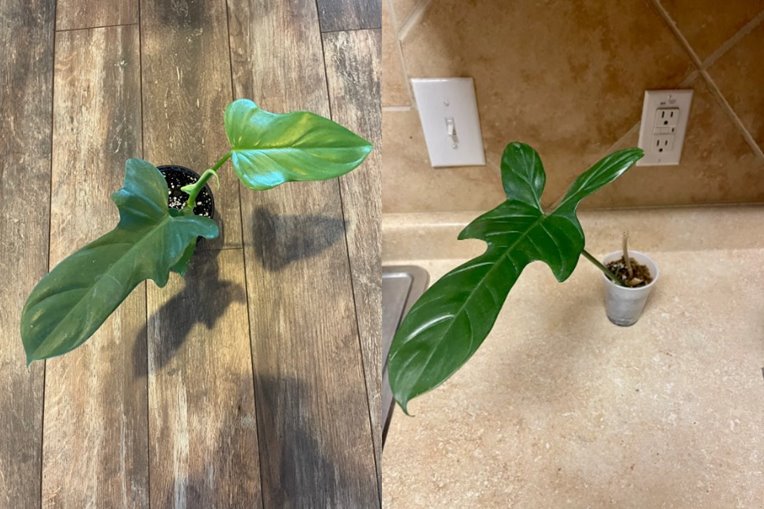
Lastly, if you compare their prices, and rarity, P. panduriforme is rarer or scarce and costs more than bipennifolium. It costs $30 to $150, while the standard green P. bipennifolium goes for $10 to $80 except for large plants with mature leaves.
Philodendron panduriforme care
Philodendron panduriforme needs growth conditions that mimic their natural habitat, i.e., warm, humid areas with filtered or bright indirect light.
Their soil should be airy, fast-draining, and high in organic matter, and you should keep it moist. Other care needs include feeding, pruning, repotting, and providing support or stake.
Here are the Philodendron panduriforme care and growth requirements:
1. USDA hardiness zone
The USDA hardiness zone for P. panduriforme is 10-11. It isn’t frost-hardy. So, you should only grow it outdoor all year if you are in these zones.
2. Temperature
The ideal temperature range is 65 to 85 degrees Fahrenheit (18-29°C). Avoid temperatures below 50°F and cold drafts. Also, don’t put your plant near a heat or cold emitting source or vent, including your AC.
3. Humidity
This plant loves humidity. So, it will grow best at high humidity, i.e., 60% or more. Nonetheless, it can tolerate moderate, i.e., 40% or more.
If your humidity is too low, raise it by misting your plants, having a pebble tray, grouping them to create a microclimate, or moving them to a more humid room like your bathroom or kitchen if it has enough light.
However, the best way to increase humidity is by buying a humidifier. There are many affordable brands to pick consider. If you have a large room, then LEVOIT Humidifiers Top Fill, 6 Liter, Cool Mist will be the best pick. Those with smaller rooms can use AquaOasis™ Cool Mist Humidifier or any cool mist brand.
4. Light needs
P. panduriforme needs bright indirect light for about 12 to 14 hours. But it can still grow in medium indirect light.
Too little light will slow growth and make new leaves smaller, yellowish, or paler. Also, your plant may be leggy. So, if your light is low, use a grow light. I have used Briignite LED Grow Light Bulb and I must stay it is awesome. It lasts for up to 50,000 hours and doesn't use much electricity, i,e,, 11watt.
On the other hand, avoid the direct hot sun as it will burn leaves. But early morning sun on the east-facing window is ok.
5. Soil mix
The best soil mix for P. panduriforme should be well-drained, aerated, and rich in organic matter. These plants are not fussy and can grow even in sphagnum moss alone.
We recommend buying an aroid mix (see Etsy.com). Or else, you can make yours by adding perlite, coco coir (or peat moss), bark chips, and compost (or worm castings) to your premium potting soil. Exact ratios don’t matter so long as it is airy, high in organic matter, and hold moisture without being soggy.
6. Watering
Water when the top 1-2 inches or up to the first knuckle of your finger feels dry. For those who have a soil moisture meter, water when the reading is in the dry zone. I use XLUX Soil Moisture Meter. This soil moisture hygrometer is accurate, responds fast, and doesn't use batteries.
We don’t recommend following a watering schedule since it varies with conditions, potting mix type, pot size or type, etc.
Lastly, when it comes to the actual watering, slowly saturate the soil until excess water flows from drainage holes. Afterward, pour any that collects into a pot saucer.
7. Fertilizer
Your plant will benefit from regular feeding. Use an all-purpose, balanced (like NPK 20-20-20 or 10-10-10) liquid houseplant fertilizer and feed once a month at half the strength the manufacturer recommends during growing months.
We use Miracle-Gro Indoor Plant Food (Liquid), and being dilute, apply after two weeks. But you are free to buy any brand, including fish fertilizer or even slow-release formula. But remember to follow the given use instructions.
8. Pruning and grooming
Remove dead, damaged, or diseased leaves or parts when you notice them with sterilized gardening shears. Also, clean dirty and dusty leaves.
During growing months, especially early spring, you can cut no more than 25% of the stems to encourage branching and control growth.
9. Repotting
Repot this aroid after 2-3 years or when rootbound, i.e., roots spiraling inside the planter and growing from drainage holes. Use a pot 2-3 larger in diameter with large enough drainage holes.
10. Support
Provide and train your P. panduriforme on a moss pole, totem, trellis, or other support since it’s a climbing type.
Philodendron panduriforme propagation
Philodendron panduriforme propagation is by stem cutting or air layering. Seeds are a viable method but are hard to find.
You can propagate your stem cutting in water or soil. To use this method, get a stem cutting with a least a node. Why? Because you cannot propagate this plant using a nodeless stem, aerial roots, or even leaves with their petioles.
On the other hand, air layering is straightforward. Select a stem you will use for propagation and wrap moist sphagnum moss around it while still attached to the mother plant. Keep the sphagnum moist and ensure it remains aerated.
Issues or problems
Yes, it is easy to grow a plant. But it doesn’t mean it is immune to issues. Some of these problems include:
1. Pests and diseases
While not uncommon, your plant may have mites, mealybugs, thrips, and scale insects. Luckily you can easily manage them with insecticidal soaps or horticultural oil sprays.
Similarly, diseases, i.e., fungal and bacterial leaf spots or blights, are also unlikely if you practice proper sanitation and isolate new plants.
2. Root rot
It is a relatively common problem if your potting mix doesn’t drain, your pot doesn’t have drainage holes, or you overwater this plant. If your plant still has some healthy roots (whitish or tan), repot it. While doing so, cut off the mushy black or brown portions.
3. Leaf discoloration – yellowing or browning
Besides discoloration due to aging affecting a few lower leaves or the one that occurs after repotting, growing conditions and care may cause discoloration.
For instance, P. panduriforme leaves turning yellow indicate you are overwatering the plant. If not, it could be too much or little light, heat stress, underwatering, cold drafts, etc.
The other common issue is brown tips and edges or leaves turning brown. It has to do with underwatering, low humidity, heat stress, too much light, fertilizer burns, etc.
Lastly, brown or yellow spots often indicate that your plant has pests or diseases. However, growing conditions and care can be causes too.
4. Leaves curling and your plant drooping
Leaves curling is a means to protect your plant or prevent moisture loss, while drooping indicates that your plant’s cells don’t have enough water.
Causes are similar, and they include underwatering, too much light, heat stress, low humidity, or anything that affects water absorption by roots or causes increased moisture loss from leaves.
Where to buy Philodendron panduriforme
If you are looking for a Philodendron panduriforme on sale, start with Etsy.com, eBay, Instagram, and Facebook. These online marketplaces and social media sites have vendors from all over the world or those willing to ship to your location. We have seen vendors from the UK, Canada, USA, Australia, NZ, NL, Germany, Singapore, etc. You cannot miss getting one.
If you don’t find it from the above sites, here are more places that ship nationally and some internationally and prices.
North America (the USA and Canada)
- Groovy Plants Ranch (Marengo, OH) - $ 71.99 (Pick up only)
- Terravita (San Francisco, CA) - $120.00
- Canopy Plant Co. (New Orleans, LA) -$75.00
- Ecuagenera USA (Orange County, FL) - $45.00
- Peace Love and Happiness Club (Seattle, WA) - USD 44.00
- Alsip Nursery (Frankfort, IL) - $64.99
- Sage Garden (Manitoba, Canada)-$34.99
- Paraiso Plant Studio (Berkeley, California) - $55.00
Europe and the UK
- Root Houseplants (Liverpool, UK) - £35.00
- Unifolia (Berlin, Germany) - €67,00
- The Plant Base (Auckland, NZ) - $45.00 (NZD)
- Grow Jungle (Sappemeer, Netherlands) €18.30
- Coast Palms & Cycads (Te Puke, New Zealand) - $45.50
Australia
- THE Plant Society – (New South Wales, Australia) -$85.00
- Talk Dirty 2 Me (Victoria, Australia) - $19.95
- Aroids Australia (Queensland, Australia) - $45.99 AUD
- The Houseplant Shop (New South Wales, Australia) - $30.00
- Uprooted (Queensland, Australia) - $10.00
If you still haven’t found a place a vendor, try googling “Philodendron panduriforme” for more locations.
Frequently asked questions (FAQs)
Yes. Philodendron panduriforme is a rare and hard-to-find houseplant. You are highly unlikely to find it at your local tropical plant stores. Also, none of the large-scale horticultural growers or big box stores sell it.
The price of Philodendron panduriforme ranges from $30 to $150 for an unrooted cutting to an established large plant. But the costs will depend on your location and where you buy it.
Whereas there is a possibility of a Philodendron panduriforme variegated form existing, most of what you see in the market is instead P. bipennifolium. Kindly be sure which one it is before spending your money.

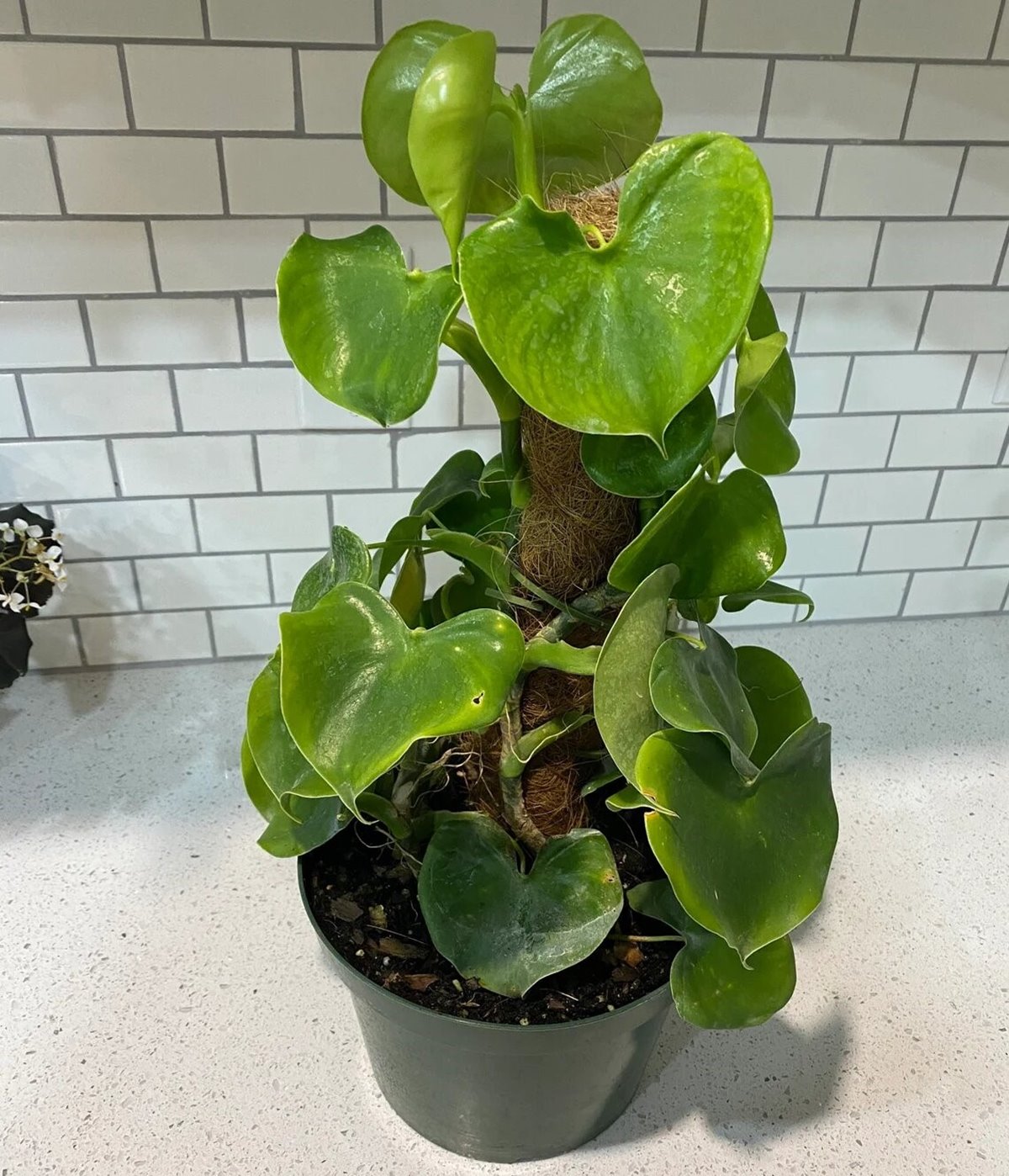
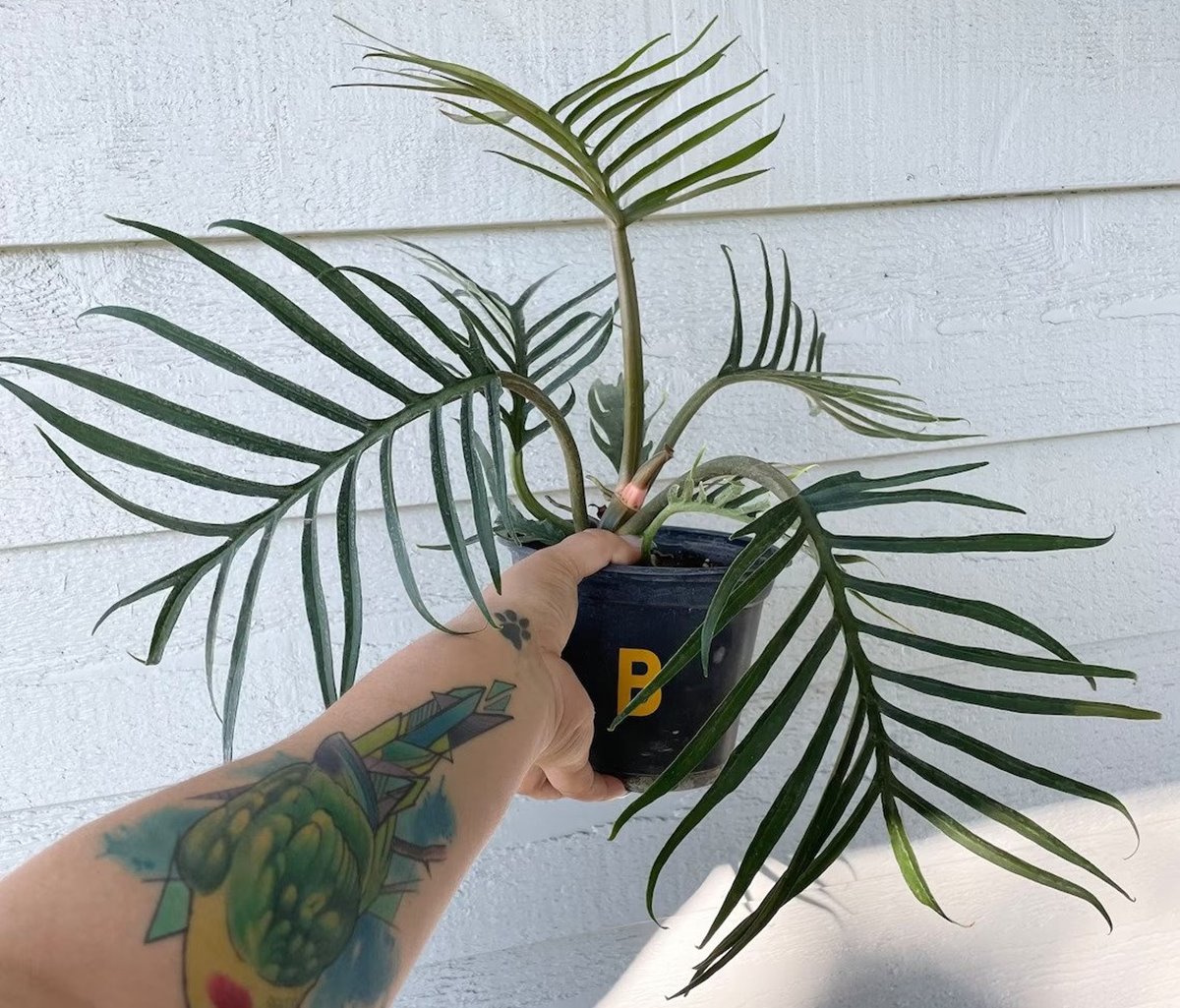
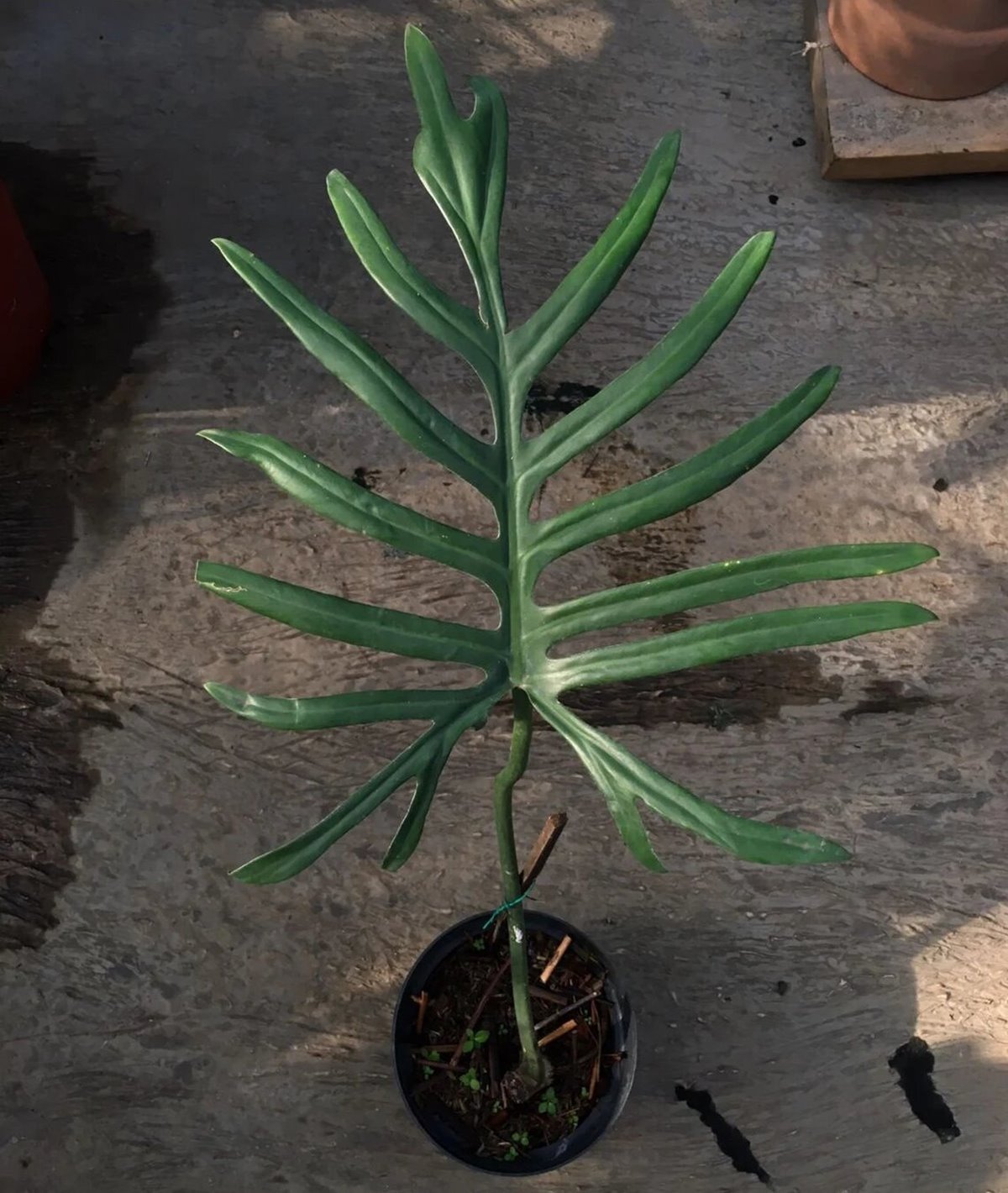

Leave a Reply